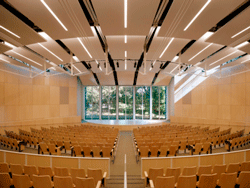Schooling in the First LEED for Schools Program
An independent Roman Catholic school serving grades preschool through 12, Sacred Heart School is the first school to obtain LEED Platinum certification under the LEED for Schools program. A platinum rating is the highest of four Leadership in Energy and Environmental Design (LEED) certification levels.
The school’s new Michael J. Homer Science and Student Life Center in Atherton features solar panels, a living roof, skylights, water-efficient systems, and an on-site organic garden. Sacred Heart’s two-story, 44,100 square-foot science center is expected to use 69% less energy than a standard building of comparable size.
Sacred Heart is the first school in San Mateo County to use fruits and vegetables from an on-site organic garden for food service in the school cafeteria. The 10,000 square-foot organic garden is operated and maintained by students in human geography, environmental science, and global studies courses.
What Actions Did Sacred Heart Take to Be Energy Efficient?
The school roof is home to a 40 kW photovoltaic array that provides 24% of the building’s energy requirements. The building is designed to use 69% less energy than a typical school building of its size in the U.S.
What Actions Did Sacred Heart Take to Save Water?
A living roof and rain-garden bioswale combine to reduce stormwater runoff by over 90% while
providing 11,500 square-feet of new habitat for native species. Landscaping was done with native plants that help reduce water used in irrigation by more than 50%. The school installed water-efficient toilets and plumbing fixtures that reduce water consumption by more than 40%, compared to standard equipment. The building is designed to use 50% less water than a typical school building of its size in the U.S.
What Actions Did Sacred Heart Take to Build Green?
The school used environmentally sensitive building materials such as interior wall insulation containing recycled cotton and denim and formaldehyde-free plywood. Over 30% of all building materials used were recycled and 75% of the wood products came from sustainably managed forests. Eighty eight percent of site and construction debris were recycled during construction and diverted from landfills. Recycling and composting stations throughout the project promoted ongoing waste management. The facility incorporates natural daylighting through the use of 73 skylights and placing the building along an east-west axis to maximize access to the sun.
What Actions Did Sacred Heart Take to Grow Sustainable Food?
Sacred Heart's large organic garden supplies the school cafeteria with fruits and vegetables. Students compost nearly 600 pounds of kitchen scraps each week along with all the newspapers from the campus library and all white paper towels used at the school.
Sacred Heart School has taken the lead by becoming the first in the nation to be awarded the Platinum LEED for Schools certification. Their efforts to create a sustainable learning environment will not go unnoticed in school communities across the country.
"One of the criteria for targeting LEED Platinum was incorporating elements that teach sustainability – this building provides endless opportunities for teaching by example.” - Colin Quinton, Sacred Heart Preparatory Science Department Head

Certified LEED Platinum, 44,100 square-foot school for grades preschool through 12th.
Climate Actions
- Generates electricity from a 40 kW solar photovoltaic system
- Built a living roof with native foliage on top
- Used sustainable and recycled building materials
- Recycled unused building materials
- Uses daylight from 73 skylights
- Planted drought-tolerant native plants
- Installed low-flow toilets and plumbing fixtures
- Grows organic vegetables that are used in the cafeteria for student lunches
- Composts cafeteria scraps and newspapers
Estimated Capital Cost
- $665,000 (2.6% of total construction cost)
Estimated Savings & Payback Period
- Cost Savings: $1.2 million in energy and water costs over a 20 year period
- Payback Period: 9-10 years
